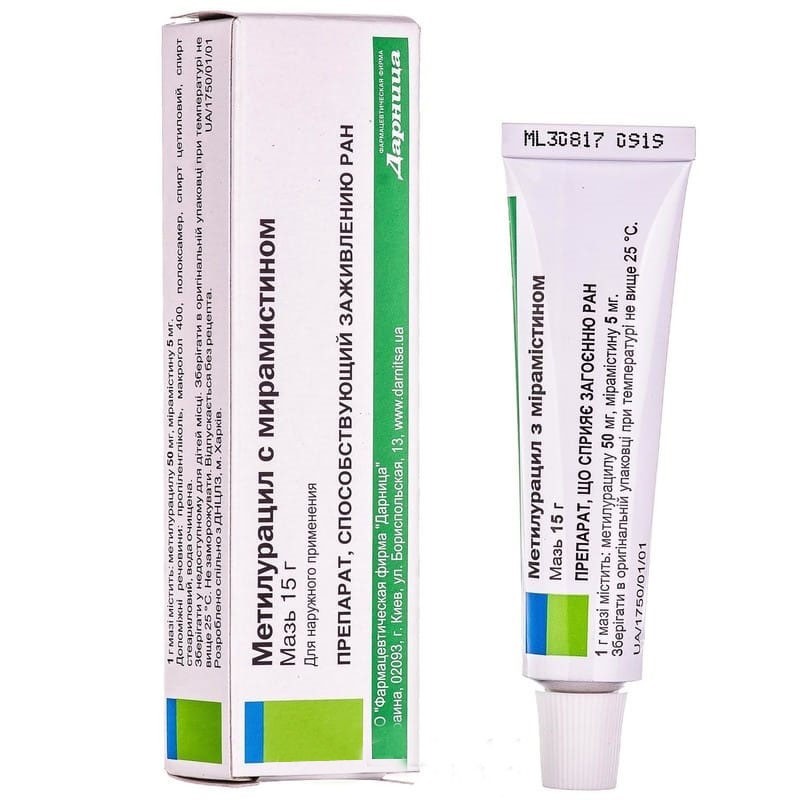



 Secure and encrypted payment processing
Secure and encrypted payment processing We ship to over 40 countries including the USA, UK, Europe, Australia and Japan
We ship to over 40 countries including the USA, UK, Europe, Australia and Japan Guaranteed refund or reship if you haven't received your order
Guaranteed refund or reship if you haven't received your orderthe drug contains methyluracil, which stimulates metabolic processes, and miramistin - a cationic antiseptic.
Methyluracil accelerates the processes of cell regeneration, wound healing, stimulates cellular and humoral immunity, has an anti-inflammatory effect.
Miramistin has a wide spectrum of antimicrobial activity, including hospital strains resistant to antibiotics. It has a pronounced antimicrobial effect in relation to gram-positive (Staphylococcus spp., Streptococcus spp., Streptococcus pneumonia) and gram-negative (Pseudomonas aeruginosa, Escherichia coli, Klebsiella spp.), Aerobic and anaerobic, spore-forming, and spore-forming microorganisms that are associated with microorganisms antibiotic-resistant strains. It has an antifungal effect on ascomycetes (Aspergillus genus and Penicillium genus), yeast (Rhodotorula-rubra, Torulopsis gabrata) and yeast-like fungi (Candida albicans, Candida tropicalis, Candida krusei, Pityrosporum orbiculare (Malassegrophyfophyta , Trichophyton verrucosum, Trichophyton schoenleini, Trichophyton violacent, Epidermophyton Kaufman-Wolf, Epidermophyton floccosum, Microsporum gypseum, Microsporum canis), as well as other pathogenic fungi in the form of monocultures and microbial associations, including fungal microflora with resistance to. Under the influence of miramistin, the resistance of microorganisms to antibiotics decreases.
At the place of use, it stimulates protective reactions and activates regeneration processes.
Due to the wide spectrum of antimicrobial action of miramistin, it effectively prevents infection of wounds and burns. The drug has a pronounced hyperosmolar activity, as a result of which it stops wound and perifocal inflammation, absorbs purulent exudate and selectively dehydrates necrotic tissue, helping to clean and dry the wound. In this case, the ointment does not damage granulation and viable skin cells, does not inhibit edge epithelization.
Pharmacokinetics Due to the properties of the ointment base to be kept on the surface of the place of application, the active substances are not significantly absorbed into the systemic circulation and usually do not cause a systemic effect.
Complicated difficult-to-heal wounds, radiation and trophic ulcers (including in patients with diabetic angiopathy, in debilitated patients with significant suppression of immunity), burns and other skin injuries. the drug has a photoprotective effect in patients with photodermatosis.
The drug is applied topically. after standard treatment of wounds and burns, the ointment is applied directly to the affected surface, after which a sterile gauze dressing is applied or the ointment is applied to the dressing and then to the wound.
You can also use swabs soaked with the drug, carefully filling the cavity of purulent wounds after surgical treatment or gauze turundas with ointment, introducing them into the fistulous passages.
The drug is used 1 time in 1-2 days. The dose depends on the area of the wound surface and the degree of purulent exudation. The duration of treatment is determined by the dynamics of wound cleansing and healing. Treatment with the drug is stopped when wound granulations appear and the wounds are cleaned of wound exudate.
Hypersensitivity to active substances or other components of the drug; acute and chronic forms of leukemia; lymphogranulomatosis; malignant bone marrow diseases.
From the immune system, skin and subcutaneous tissue: hypersensitivity reactions, including hyperemia, itching, a slight burning sensation, rash, urticaria; dry skin, dermatitis, weeping and due to the content of propylene glycol in the preparation - skin irritation.
If any adverse reactions occur, discontinue use of the drug and consult a doctor.
The drug is used with caution in patients with neoplasms who undergo radiation and chemotherapy.
The effectiveness of the drug increases if it is applied to the wound surface, previously washed with aseptic solution. The presence of purulent-necrotic masses in the wound requires an additional consumption of ointment.
With a deep localization of the infection in the soft tissues, it is possible to use the drug in combination with systemic antibiotics.
Use during pregnancy and lactation. Due to the lack of controlled studies on safety and effectiveness, the drug should not be used during pregnancy and lactation.
Children. Due to the lack of sufficient experience in the use of the drug should not be prescribed in pediatric practice.
The ability to influence the reaction rate when driving vehicles or working with other mechanisms. There is no data on the ability of the drug to affect the reaction rate when driving vehicles or working with other mechanisms.
With simultaneous local use of miramistin with anionic surfactants (soap solutions), it is inactivated.
With the simultaneous use of miramistin with systemic or local antibiotics, a decrease in the resistance of microorganisms to the latter was noted.
With the simultaneous use of methyluracil with strophanthin, antibiotics, sulfonamide drugs, an increase in their effectiveness is noted, and with pentoxil, an increase in its toxic effects.
With simultaneous use with local corticosteroids, its effectiveness is reduced.
Overdose phenomena are not noted. however, when applying the drug to large surfaces of the affected skin, the possibility of a partial penetration of the active components of the ointment into the systemic circulation in quantities that are not capable of causing acute poisoning is not ruled out. manifestations of the systemic effects of methyluracil are headache, dizziness, hypersensitivity reactions. Miramistin acts as a cationic detergent and can prolong bleeding time. with an overdose caused by the prolonged use of a large amount of ointment, changes in blood composition are possible due to the influence of methyluracil on hematopoiesis processes.
Treatment: dose reduction or drug withdrawal, symptomatic therapy.
In the original packaging at a temperature not exceeding 25 ° C. do not freeze.